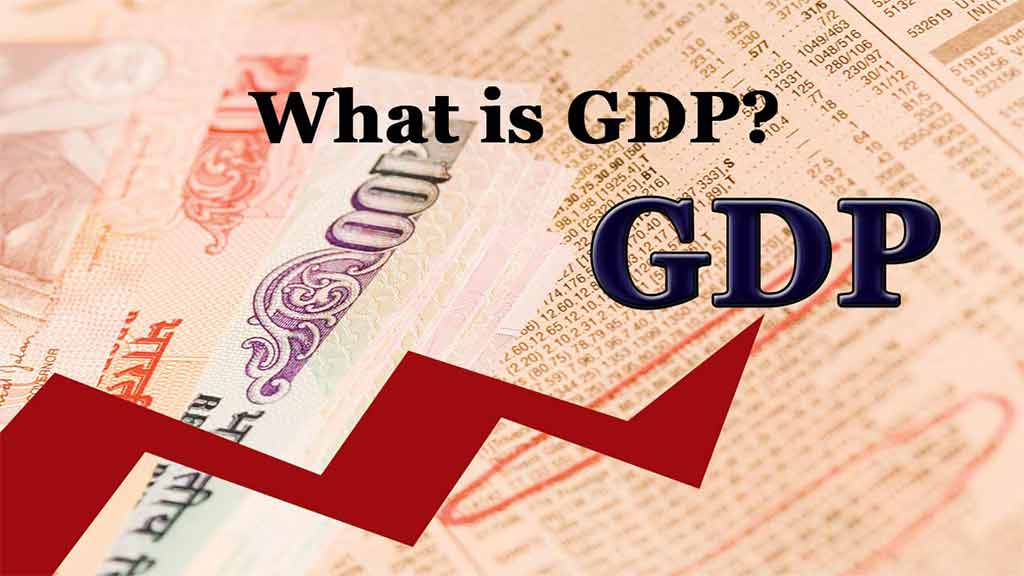What is GDP? History of GDP, Components of GDP and Calculation: The full form of GDP is Gross Domestic Product. The value of economic activity within the specified country is measured using GDP.
In other words, we can say the sum of the final prices of the goods and services that is produced within the boundary of a country during a given period.

For India, GDP is around US $2.8 trillion within a specified period i.e. from 1st April to 31st March.
GDP is a very important topic from exam point of view. Many related questions are asked in different Govt exam.
What is GDP(Gross Domestic Product)?
GDP or Gross Domestic Product is the value of all the final Goods Services that produces within a country in a specified time period. GDP is calculated in local currency which is a number only.
GDP represents the final monetary value of goods and services which is produced within boundary of a country.
Key Points:
- GDP gives an idea about the size of economy and growth rate of any country.
- GDP is used to adjust inflation and population providing in-depth information and calculated in three ways such as on expenditure, production or income basis.
- GDP helps policy makers, investors and business man to take decisions accordingly.
History of GDP
In 1937, in response to Great Depression, in a report first time give focus on attention which is conceived of and presented by Simon Kuznets, an economist of National Bureau of Economic Research.
Previously, GNP was the preeminent system. In 1944, after Bretton Woods Conference to measure national economics GDP was adopted widely.
Key Points on India’s GDP:
- Previous base year was 2004-05 but in 2015 the government of India changed this year and decided 2011-12 as new base year for national accounts.
- Earlier, Central Statistics Office (CSO) calculated GDP considering factor cost but now it considers the market price to calculate GDP.
- In 2004-05, growth rate of the economy was 4.7% but according to the new base year, the growth of economy was 6.9%.
Understand the Concept of GDP:
When calculating GDP, it includes all types of investment, consumption made by public and private, government outlays, construction cost and the foreign balance of trade (where exports are added and imports are subtracted). The foreign balance of trade is very important out of all the components of GDP.
The total value of goods and services produced by domestic producer will tend to increase country’s GDP when selling to foreign markets increases the total value of foreign goods and services that is brought by domestic consumers. This situation is known as trade surplus.
On the other hand, when domestic consumers spend more amount on foreign products than the domestic producer able to sell in foreign markets. This situation is known as trade deficit and also lowers the GDP rate.
Components of GDP
To measure GDP several parameters are used for different purposes.
Nominal GDP:
GDP may be measured in local currency or in U.S dollars at current market price and in present currency exchange rate to compare GDP with other countries.
GDP, Purchase Power Parity (PPP):
Using the method of Purchasing Power Parity (PPP), GDP is measured in international dollars in order to adjust the difference in local prices and cost of living to make comparison with the real output, real income and living standards of other countries.
Real GDP:
when inflation adjusted GDP is measured which represents the quantity of goods and services produced within a specified time in a country. Price are made fixed from year to year to differentiate the effect of inflation or deflation over a period of time.
GDP Growth Rate:
By GDP Growth rate we can compare GDP of country’s present year with the previous year to determine how fast the economy is growing. Generally, represented in percentage (%).
GDP Per Capita:
When the GDP of every person of a country is measured it is called GDP Per Capita. It expressed income of every person in the economy.
Different Types of GDP Calculating
There are three primary methods to calculate GDP. When all the three methods are calculated correctly it would give the same number. The three methods are (I) The Expenditure Approach (II) The Product (Output) Approaches (III) The Income Approach.
(I) The Expenditure Approach
In the expenditure approach, spending of different groups is calculated who take participation in the economy. So, it is also called spending approach. We can calculate this approach by using the expression:
GDP = C + G + I + NX
Where C = Consumption, G = Government Expenditure, I = Investment, NX = Net Exports
Consumption indicates money spend by consumer or expenditure due to private consumption. To avail goods and services, consumer spends money. In GDP, one of the biggest component is consumers spending.
Government spending indicates the amount of investment and expenditure made by government. Government spend funds in different purposes such as infrastructure, Payroll, Equipment.
Investment represents domestic investment made by private sectors or capital expenditures. Different private sector invests their funds in business activities for growth and development.
Net export indicates the subtraction of total export and total imports (NX = Exports – Imports).
(II) The Output Approach
This approach is totally opposite of the expenditure approach. Here the total value of economic output and deducts the cost intermediates.
(III) The Income Approach
To calculate income approach, factors of production of economy such as wages paid to labor, the rent earned by land, interest earned from a certain capital & corporate profits are calculated which are a form of income.
In this approach, there are some factors which are not considered as payment are adjusted.
For example: sales tax, property tax which are considered as income tax. Depreciation which may wear down with the use is also added when calculate National Income. All of these are considered when calculating National Income.
Symbolically: National Income = Total rent + Total Wages + Total Interest + Total Profit
Rebasing of GDP in India
- As the GDP indicates the real scenario of the economy of structural changes, other different sectors contribution etc. The government of India Rebasing the GDP of India time to time.
- Presently, CSO rebasing on the recommendation of SNA (System of National Accounts) which is published in 2008 by UN.
Comparison of the method of estimation of GDP
- Previously, Index of Industrial Production (IIP) was used to track economic activities in different sectors. In this system, change of values was not considered rather change in volume was taken into consideration. But in present method, GVA (Gross Value Added) concept is used where the value addition is measured which is happened in the economy.
- In the previous method, the data of IIP was used to estimate GDP and using ASI (Annual Survey of Industries) data it was updated. Only those firms which comes under the factory act and registered with it were accountable for. But in new method, data of MCA21 (Ministry of Corporate Affairs) which was launched in 2006, an e-governance is used. Those companies /firms that file their financial activity electronically. Approximate more than 5,00,000 firms data is collected under this.
- In the previous system, income from the agricultural sector was not clear and production of farms was considered. But in the new method, there is a wide scope to calculate the addition of value in agriculture.
- In the previous method, most of the NBFCs and mutual funds were not considered in the financial activities. But in new technique, it extended its coverage area and has included pension funds, asset management funds, stock exchange, stockbroker etc.
Issues in New Method
- Parameters of the other microeconomics is not reflected in the revised data such as credit growth, corporate sales, tax revenues, investment level in the economy, trade performance etc.
- It is unable to compare the growth or production earlier than 2008, as MCA21 has collected data from 2008.
- In FY21 (Financial Year) 07 to FY21, the bank credit growth was 20.3% and between FY13 to FY18 it was 12.3%. During this period, the growth rate of GDP was 6.7% and 6.9% compared to earlier which was 8% and 6.9% respectively.
- Between FY07 to FY12 the average inflation rate was 9.6% and after that it was 6.4%. Then if the growth is increased due to high demand, inflation in the second part should also be increased.
Positive Approach of New Method
- It can be explained the declination of bank credit growth and it is due to the increased capital efficiency. For example, in Corporates using instruments like bonds, commercial papers etc. banks invest their funds.
- Inconsistency in investment, increased economic efficiency is happened but the relationship between growth and investment is not clear. If consumption increases, then the investment will also increase.
- There is also variation in tax collection because of the factors such as higher compliance, frequent change in tax rates etc.
Future of this Method
- If CSO work independently and allowed to calculate, seek feedback and publish date then the results will be more realistic and reflective.
- CSO can work with experts to make it more clear.
- However, the government has announced the new base which is 2018-19 and these figures will be changed again.
General Awareness:
Follow us on Facebook and Twitter.
Frequently Asked Questions
Q1. What is the full form of GDP?
Ans: The full form of GDP is Gross Domestic Product.
Q2. What is the present base year for the calculation of GDP?
Ans: The present base year for the calculation of GDP is 2011-12.
Q3. Which organization is responsible for the calculation of GDP?
Ans: CSO (Central Statistics Office) is responsible for the calculation of GDP.





